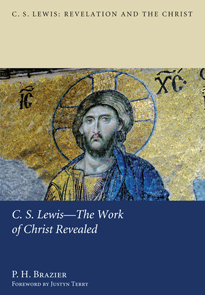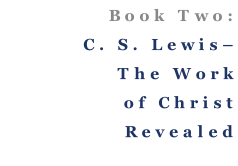

Revelation
The Christ



Outline
Contents
C. S. Lewis - The Work of Christ Revealed
Part One
Scripture - Revelation Transposed
Chapter 1 Scripture, Revelation and Reason I: Scepticism and Suspicion
Chapter 2 Scripture, Revelation and Reason II: Mediation and the Bible
Chapter 3 Scripture, Revelation and Reason III: Idealism and Transposition
Part Two
The Revelation of Christ - God, or a Bad Man
Chapter 4 aut Deus aut malus homo I: What did Lewis Say?
Chapter 5 aut Deus aut malus homo II: The Theological Tradition
Chapter 6. aut Deus aut malus homo III: Divine Self-Disclosure
Chapter 7. aut Deus aut malus homo IV: Arguments For and Against
Chapter 8. aut Deus aut malus homo V: Lewis’s Trilemma
Part Three
Christ Prefigured - Intimations to the Pagans
Chapter 9. Christ as the Light of the World I: A Doctrine of Christological Prefigurement
Chapter 10. Christ as the Light of the World II: Revelation and Meaning - Imagination, Illumination and Prevenience
Chapter 11. Christ as the Light of the World III: Refractions - Splintered Fragments of the True Light
Each chapter is subdivided into multiple sections
and sub-sections. Click here for a detailed contents :


This is the second book in the series. This book consists of three parts, eleven chapters in all; each chapter opens with a synopsis (of between 200 and 500 words) of the content and argument contained therein. Some chapters are quite long, but nonetheless are a coherent thematic whole despite their length. All chapters are divided into multiple sections and sub-sections to allow for ease of access to the material contained in these long chapters.
C. S. Lewis The Work of Christ Revealed focuses on three doctrines or aspects of Lewis's theology and philosophy: his doctrine of Scripture, his famous mad, bad, or God argument, and his doctrine of christological prefigurement. In each area we see Lewis innovating within the tradition. He accorded a high revelatory status to Scripture, but acknowledged its inconsistencies and shrank away from a theology of inerrancy. He took a 2,000-year-old theological tradition of aut Deus aut malus homo (either God or a bad man) and developed it in his own way. Most innovative of all was his doctrine of christological prefigurement intimations of the Christ–event in pagan mythology and ritual.
C.S. Lewis: Revelation and the Christ, Book Two
C. S. Lewis – The Work of Christ Revealed
Part One, Scripture – Revelation Transposed
Part One (Chapters one to three) is about Lewis's doctrine of scripture. An assessment of C.S. Lewis on the Bible, his doctrine of scripture will tell us much about the basis of his understanding of revelation and the Christ: person, act, event. Lewis connects revelation with illumination, how the writers of scripture were inspired. Lewis lays great stress on the humanity of scripture – infinite wisdom, which comes down and is beyond complete human comprehension. How reliable is the picture we have of Christ from scripture? What value did Lewis accord to scripture? Lewis was highly critical of modern biblical criticism where it attempted to reduce and explain away, where it sought to demythologize. Lewis questioned the expertise of “modern” critics in understanding genre and literary types, where this understanding was based on the mistaken notion of historical superiority, and a denial of the miraculous.
Can we deduce a doctrine of scripture in Lewis’s work? Did Lewis regard the Bible as inerrant? What authority does scripture hold? Does it have special status over all other books? What does it mean to say it is the Word of God? For Lewis, God was infallible, yet God also allowed for the freedom of creation to be; hence, the writers of scripture were divinely inspired, but were Fallen and fallible: God breathed, the Holy Spirit imparted intimations to the human mind, though the mind is free to make of these intimations what it will. For Lewis the very act of reading is revelatory. Lewis, like Karl Barth, distinguishes between the word of God (scripture) and the Word of God (Christ). We can consider what other theologians have written on Lewis’s understanding of how God reveals of God’s self to humanity, and how they identify and categorize modes of revelation: the numinous (God’s holiness); the universal ought (moral responsibility); Sehnsucht (wistful longings); election (Israel and the law); good dreams (Pagan premonitions of Christ), even, for Lewis, the natural world. However, these categories exclude scripture and the developing Church tradition that constituted Lewis’s “mere” core, therefore, these categories need to be ranked hierarchically in relation to the concrete, perfect and particular revelation that is the incarnation: the Word of God revealed. All revelation must be seen as related to Christ the mediator. Lewis therefore saw all revelation perceivable by humanity as coming from Christ who is the true Word of God.
We need to consider something of Lewis’s background as a philosopher, and how his thought is formed through his reading of the seventeenth century Cambridge Platonists, and the eighteenth century Irish philosopher George Berkeley, which drew him yet again back to Plato. Lewis proposed what he called a doctrine of transposition, which was heavily reliant upon Platonic concepts, but also on the Patristic theologian and philosopher Augustine. Revelation is transposed, changed, altered, without one-to-one correspondence. Lewis’s doctrine of transposition is designed to explain how revelation works, how revelation is communicated, or, more pertinently, how revelation can never be fully imparted; this we conclude relates to the communicatio idiomatum (the communication of attributes), the knowability of God (which is both a veiling and an unveiling), and how human fallibility can lead us to misread what is communicated to us. Lewis referred to his doctrine of transposition as his contribution to the philosophy of the incarnation.
Part Two, The Revelation of Christ – God, or a Bad Man
Part Two (chapters four to eight) is based on the proposition that Jesus was “Bad, Mad or God.” This is central to C.S. Lewis’s popular apologetics, and he used it often to argue for the truth of the Gospel. It is fêted by American Evangelicals, cautiously endorsed by Roman Catholics and Protestants, but often scorned by philosophers of religion. Most, mistakenly, regard Lewis’s trilemma as unique, however, we can trace its origin to Jesus’ question to Peter: “But who do you say that I Am?” (Matthew 16:15, c.f. Mark 8:27-30 and Luke 9:20-21) and thereby we can examines the roots of this proposition in a two thousand year old theological and philosophical tradition (that is, aut Deus aut malus homo – “either god, or a bad man”): for example in the fourth century writings of Gaius Marius Victorinus, in his apologetic arguments to counter Julian the Apostate, we can also find reference to it in medieval scholasticism, and in the writings of Sir Thomas More; however, its use is essentially post-Reformation, in response to the scepticism of the Age of Reason and the Enlightenment: “What do we say about Jesus if he was not God incarnate?” The work of the Victorian churchman and theologian H.P. Liddon (Christus, si non Deus, non bonus – “Christ, if not God, is not good”) is important here, along with the nineteenth-century American preacher and theologian Mark Hopkins. The origin of Lewis’s use is in the influence of G.K. Chesterton.
As such this is grounded in the Johannine trilemma (that Jesus was taken to be an “unbalanced liar,” or he was castigated as “demonically possessed,” or he was perceived to be “the God of Israel come amongst his people”). Therefore Jesus can only be understood in the context of the Jewish religious categories he was born into; therefore, for Lewis, Jesus is who he reveals himself to be. Jesus’ self-understanding reflects his identity, his triune salvific role; this is for Lewis, the transposed reality of divine Sonship. Reason and logic are paramount here, reflected in the structure of Lewis’s argument.
What is the structure of Lewis’s argument? Is it bipartite or tripartite? As popular apologetics Lewis presents the argument as a 1+2 trilemma specifically using simplistic language: a) mad, b) bad or c) God (MBG or BMG). How does this compare with other examples of trilemmas – both religious and secular. Many have attempted to analyze Lewis’s trilemma – chief among them are Peter Kreeft and Stephen T. Davis. Lewis’s trilemma is not so much a proof of God’s existence, but a question, a dilemma, where each and every person must come to a decision. For all its perceived faults, its simplistic language, Lewis’s trilemma still is a very successful piece of Christian apologetic, grounded in a serious philosophical and theological tradition.
Part Three, Christ Prefigured – Intimations to the Pagans
Part Three (nine to eleven) is an an examination of the Christology that C.S. Lewis read from the apparent prefiguring of elements of the incarnation-resurrection narrative in non-Christian religious myths. This is in effect what we may term a doctrine of Christological prefigurement. Such a doctrine is summarised in two propositions: first: the actuality of the historic event of the incarnation-cross-resurrection was previsioned Pagan religion and myth (i.e. in non-Judaic-Christian religious stories and myths); second: the Gospel account, the incarnation-cross-resurrection narrative, acts on us, whether spoken or read, both as fact and myth. From his teenage years on Lewis the apostate atheist held the North European Pagan myths in very high regard. This was related to his love of Wagner’s music, which is rooted in such myths; but he also valued Middle Eastern and Asiatic-Indian-Oceanic myths – in particular ancient Hindu. However, with his conversion he chose not to reject these Pagan myths out-of-hand but try to understand how they related to the Christ event: an event that was an actuality that he had come to realise was central to human history.
Initially we need to examine what we mean by myth and reality, by fact and fiction. Lewis’s writings on the myth that became reality (the incarnation-resurrection) are discussed along with examples of prefigurement (in particular the myth of Balder the Beautiful). By examining the relationship between religion and human creativity we can establish a paradigm – that revelation precedes religion. In contrast to his earlier deference for the conclusions of the Victorian colonial religionist and social anthropologist Sir James George Frazer (conclusions rooted, as they were, in a Feuerbachian-Freudian interpretation of a Darwinian model of human evolution, which classified religion as a tribal human construct to a hostile world), Lewis came to regard these prefigurements as the work of the Holy Spirit – intimations of God’s salvific action in Christ.
Some may consider there to be a problem with a doctrine of Christological prefigurement because it appears to do an injustice to the original aims and intentions of the author of the myth in asserting a second, a subsequent, Christological level of meaning? Lewis thought not, and could defend such an interpretation. Through his understanding of natural theology, revelation and human imagination (proximately to that of Augustine, but also to the English Romantics, especially the poet, theologian and philosopher Samuel Taylor Coleridge) Lewis’s esteem, prior to his conversion, for Pagan myths relating to the appearing (incarnation?) and reviving from death (resurrection?) of Pagan gods, avatars and spirits, led him after his conversion to analyse why and how these religious myths/stories related to the actual Christ event. Lewis’s understanding in this is contiguous to Coleridge and George MacDonald, but also J.R.R. Tolkien (from whom he learns and uses many concepts – for example, sub-creation, mythopoeic/mythopoeia, refractions and splinters of the true light, also eucatastrophe). His cautious respect for these intimations of prefigurement was as a mode of revelation rooted in Augustine’s doctrine of illumination and the proposition that there is no un-aided true knowledge of God.
Following on from what we have established with regard to the prefigurement of the incarnation-resurrection narrative, and in the light of what we have concluded on meaning and revelation, imagination, illumination and prevenience, Lewis’s doctrine of Christological Prefigurement leads us to ask three groups of questions. First, how do these prefigured ideas come to be in these myths and how do these intimations, splintered fragments of the true light, relate to Lewis’s understanding of Christ as the light of the world? Are these intimations the product of mythopoeia, or of demonic mimicry? The second group of questions centre on how the incarnation-resurrection narrative acts and operates on us as a myth whether spoken or read (a baptized imagination is crucial here for Lewis in both the creation and receiving/hearing of such narratives). The third group of questions relate to the internal evidence for a mythopoeic interpretation within the incarnation-resurrection narrative? Lewis asserted that the incarnation-resurrection narrative operates on us both as fact and myth – was he right? Do these prevision narratives – and the Gospel story – act on us in a perlocutionary manner? Why does the incarnation-resurrection narrative appear to resonate with agrarian corn myths the world over? Lewis concluded that “the pattern is there in nature because it was first there in God,” that there is a death descent/rebirth-reascent paradigm written into creation. Jesus Christ is not another example of this paradigm, he is the Lord of creation, nature’s creator, the author of the paradigm.
Download this essay in PDF:
PDF :: C.S. Lewis–The Work of Christ Revealed
If citing this essay please use the following:
P.H. Brazier, ‘C.S. Lewis–The Work of Christ Revealed’ www.cslewisandthechrist.net/csl_the_work_of_christ_revealed.html.
and then give paragraph numbers and date accessed

PDF:




Home
Book One
Book Two
Book Three
Book Four
Links
Contact
“In the Highest Degree”








Author

